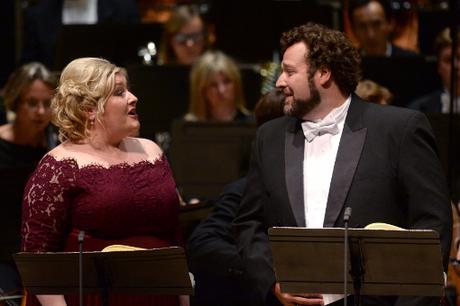
Karen Cargill and Bryan Hymel ride the highway to hell in Berlioz' La damnation de Faust.
Photo by Doug Peters for PA Wire © 2017 London Symphony Orchestra.
This is the LSO’s third recording of Damnation and its first not by the late Sir Colin Davis. Forty years ago, that maestro was responsible for the popularization and assimilation if Berlioz’ music into the classical mainstream, conducting and recording his catalog of stage and concert works in a series of records for Philips. Sir Colin also helped springboard the LSO going “indie” with its own record label and another Berlioz cycle. So this ever popular work, not quite a concert opera, not quite an oratorio (Berlioz called it a “tragedies-lyrique”) is a good choice for Sir Simon's first recorded excursion with his new ensemble.
First, there's the recording itself, in an astonishing dynamic range that picks up,the small details of this score and renders them like jewels on velvet. Little things like the tremolo violins in the opening already sound like the licking flames of hell around Faust’s ankles. Sir Simon's breadth of experience serves him well, having helmed both modern and period recordings in the past. Berlioz needs a bit of both approaches, and the welcome presence of archaic brass instruments. The most prominent of these is the ophicleide, a honking, murky-toned ancestor of the orchestral tuba. Its presence adds a certain authenticity to the big passages.
As played by Bryan Hymel, the luckless Doctor has the right hint of melancholia as if he is doomed from the start. Mr. Hymel leaped to prominence a few years ago in the Met’s Les Troyens. His performance is the golden thread that holds this performance together. It's not always the prettiest tone but it is powerful and involving throughout, maintaining its presence in the arduous evocation to Nature in the climactic pages of the work. His Wilhelmina scream as Faust is sucked into darkness is astonishing.
Mephistopheles here is a substitute, the baritone Christopher Purves. (Gerald Finley was booked, but indisposed.) Though he sings with sweet and seductive tone in the scenes with Faust, he doesn't’t do so well when called upon for satanic majesty. This is an under-powered devil, who nevertheless carries on in eloquent French. The performance finally comes into its own in the scene where Faust rides straight into hell, though his triumph is quickly swallowed up by the yowling madness of Berlioz’ choral writing.
Karen Cargill’s Marguerite doesn't appear until halfway through this work, but she immediately makes a substantiation impact. Her “Chanson de Le roi de Thule” is sung with a vibrato,that suggests her freshness and vulnerability. The tone hardens and brightens in her scenes with Faust and loss On my way! Fully in the great aria “L’amoire l’ardente flamme”, rising in great purity a pad beauty as she arcs over the sumptuous orchestra.
Sir Simon is also blessed with the excellent London Symphony Chorus. They succeed at impersonating peasants, penitents and finally, shrieking , chattering Pandemonium. They are essential here in breathing life into Berlioz’ vast musical imagination. The choral direction is so precise that the “Requesciat in pace” and the series of fugal “Amens” that follow Brander’s "Chanson de rat” are actually sung with a slightly, deliberately flattened tone, as if to inject sarcastic venom into the music. (The same affectation is present in the “Santa Maria” sung before the Ride into the Abyss.)
The orchestra knows this music cold, from the brassy blare of the Marche hongroise (again, those ophicleides!) to the peasant snap-rhythms that accompany the tavern songs. (Baritone Gabor Bretz delivers a small pleasure with his “Chanson de Rat.”) Things shift subtly in the magical passage that comes right before the Dance of the Sylphs. (Here, Berlioz introduces the possibility of redemption into this dark and cynical world, even as Mephistopheles croons over the sleeping Faust.)
The level of playing remains high, with the flames rising audibly around Faust as his downward path steepens. The Ride into the Abyss is absolutely apocalyptic, as brass and percussion blossom in a giant explosion of sound. The redemption scene at the end is taken at a ponderous speed, with Sir Simon drawing the longest and best notes from his orchestra and chorus. All rise to the occasion.
If you enjoyed this article, it's time to click over to Superconductor's Patreon page, and help support the cost of independent music journalism in New York City at the low cost of just $5/month.

